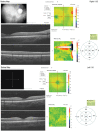Characterization, passive and active treatment in strabismic amblyopia: a narrative review
- PMID: 32685403
- PMCID: PMC7321947
- DOI: 10.18240/ijo.2020.07.18
Characterization, passive and active treatment in strabismic amblyopia: a narrative review
Abstract
Strabismic amblyopia is characterized by a distorted spatial perception. In this condition, the neurofunctional disorder occurring during first years of life provoke several monocular and binocular anomalies such as crowding, deficits in the accommodative response, contrast sensitivity, and ocular motility abilities. The inhibition of the binocular function of the brain by the misaligned amblyopic eye induces a binocular imbalance leading to interocular suppression and the reduction or lack of stereoacuity. Passive treatments such as occlusion, optical and/or pharmacological penalization, and Bangerter foils has been demonstrated to be potentially useful treatments for strabismic amblyopia. Recent researches have proved new pharmacological options to improve and maintain visual acuity after occlusion treatment in strabismic amblyopia. Likewise, the active vision therapy, in the last years, is becoming a very relevant therapeutic option in combination with passive treatments, especially during and after monocular therapy, in the attempt of recovering the imbalanced binocular vision.
Keywords: Bangerter foil; amblyopia; occlusion; penalization; strabismic amblyopia; strabismus; vision therapy.
International Journal of Ophthalmology Press.
Figures
References
-
- Hashemi H, Pakzad R MSc, Yekta A, et al. Global and regional estimates of prevalence of amblyopia: a systematic review and meta-analysis. Strabismus. 2018;26(4):168–183. - PubMed
-
- Elflein HM. Amblyopia. Epidemiology, causes and risk factors. Ophthalmologe. 2016;113(4):283–288. - PubMed
-
- Vagge A, Nelson LB. Amblyopia update: new treatments. Curr Opin Ophthalmol. 2016;27(5):380–386. - PubMed
Publication types
LinkOut - more resources
Full Text Sources

